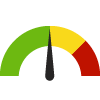Disparities Dashboard
Indicator Gauge Icon Legend
Legend Colors
Red is bad, green is good, blue is not statistically different/neutral.
Compared to Distribution
 the value is in the best half of communities.
the value is in the best half of communities.
 the value is in the 2nd worst quarter of communities.
the value is in the 2nd worst quarter of communities.
 the value is in the worst quarter of communities.
the value is in the worst quarter of communities.
Compared to Target
 meets target;
meets target;  does not meet target.
does not meet target.
Compared to a Single Value
 lower than the comparison value;
lower than the comparison value;
 higher than the comparison value;
higher than the comparison value;
 not statistically different from comparison value.
not statistically different from comparison value.
Trend

 non-significant change over time;
non-significant change over time; 
 significant change over time;
significant change over time;  no change over time.
no change over time.
Compared to Prior Value
 higher than the previous measurement period;
higher than the previous measurement period;
 lower than the previous measurement period;
lower than the previous measurement period;
 no statistically different change from previous measurement period.
no statistically different change from previous measurement period.
 Significantly better than the overall value
Significantly better than the overall value
 Significantly worse than the overall value
Significantly worse than the overall value
 Significantly different than the overall value
Significantly different than the overall value
 No significant difference with the overall value
No significant difference with the overall value
 No data on significance available
No data on significance available
City: District of Columbia
Community / Social Environment
City: District of Columbia Teens who Used 3+ Hours of Computer
City: District of Columbia Teens who Used 3+ Hours of Computer


City: District of Columbia Teens who Watched 3+ hours of Television
City: District of Columbia Teens who Watched 3+ hours of Television


City: District of Columbia Youth Who Watch 3+ Hours of Television
City: District of Columbia Youth Who Watch 3+ Hours of Television

City: District of Columbia
Community / Transportation
City: District of Columbia Households without a Vehicle
City: District of Columbia Households without a Vehicle



City: District of Columbia Mean Travel Time to Work
City: District of Columbia Mean Travel Time to Work




City: District of Columbia Workers Commuting by Public Transportation
City: District of Columbia Workers Commuting by Public Transportation




City: District of Columbia Workers who Drive Alone to Work
City: District of Columbia Workers who Drive Alone to Work




City: District of Columbia
Economy / Food Insecurity
City: District of Columbia Food Insecurity Rate
City: District of Columbia Food Insecurity Rate





City: District of Columbia
Economy / Housing & Homes
City: District of Columbia Overcrowded Households
City: District of Columbia Overcrowded Households

City: District of Columbia Renters Spending 30% or More of Household Income on Rent
City: District of Columbia Renters Spending 30% or More of Household Income on Rent





City: District of Columbia
Economy / Income
City: District of Columbia Median Household Income
City: District of Columbia Median Household Income




City: District of Columbia Per Capita Income
City: District of Columbia Per Capita Income




City: District of Columbia
Economy / Poverty
City: District of Columbia Children Living Below Poverty Level
City: District of Columbia Children Living Below Poverty Level




City: District of Columbia Families Living Below Poverty Level
City: District of Columbia Families Living Below Poverty Level




City: District of Columbia People 65+ Living Below Poverty Level
City: District of Columbia People 65+ Living Below Poverty Level




City: District of Columbia People 65+ Living Below Poverty Level (Count)
City: District of Columbia People 65+ Living Below Poverty Level (Count)

City: District of Columbia People Living Below Poverty Level
City: District of Columbia People Living Below Poverty Level





City: District of Columbia Young Children Living Below Poverty Level
City: District of Columbia Young Children Living Below Poverty Level




City: District of Columbia Youth not in School or Working
City: District of Columbia Youth not in School or Working




City: District of Columbia
Education / Educational Attainment
City: District of Columbia People 25+ with a Bachelor's Degree or Higher
City: District of Columbia People 25+ with a Bachelor's Degree or Higher




City: District of Columbia People 25+ with a High School Diploma or Higher
City: District of Columbia People 25+ with a High School Diploma or Higher




City: District of Columbia Veterans with a High School Diploma or Higher
City: District of Columbia Veterans with a High School Diploma or Higher




City: District of Columbia
Education / Student Performance K-12
City: District of Columbia 4th Grade Students Proficient in Math
City: District of Columbia 4th Grade Students Proficient in Math


City: District of Columbia 4th Grade Students Proficient in Reading
City: District of Columbia 4th Grade Students Proficient in Reading


City: District of Columbia 8th Grade Students Proficient in Math
City: District of Columbia 8th Grade Students Proficient in Math


City: District of Columbia 8th Grade Students Proficient in Reading
City: District of Columbia 8th Grade Students Proficient in Reading


City: District of Columbia
Environmental Health / Built Environment
City: District of Columbia Access to Parks
City: District of Columbia Access to Parks




